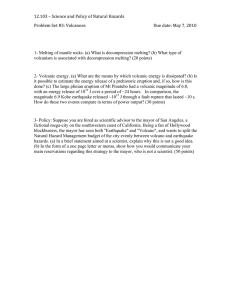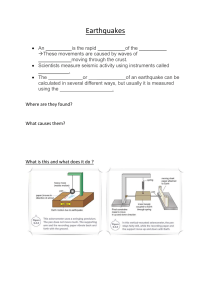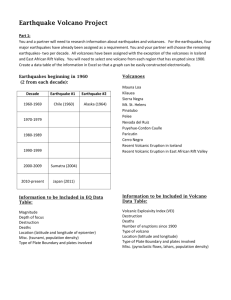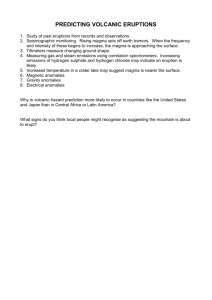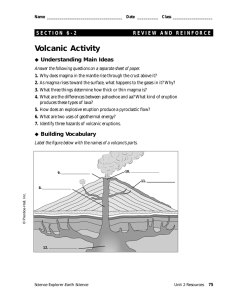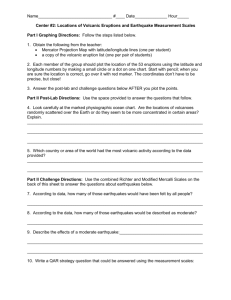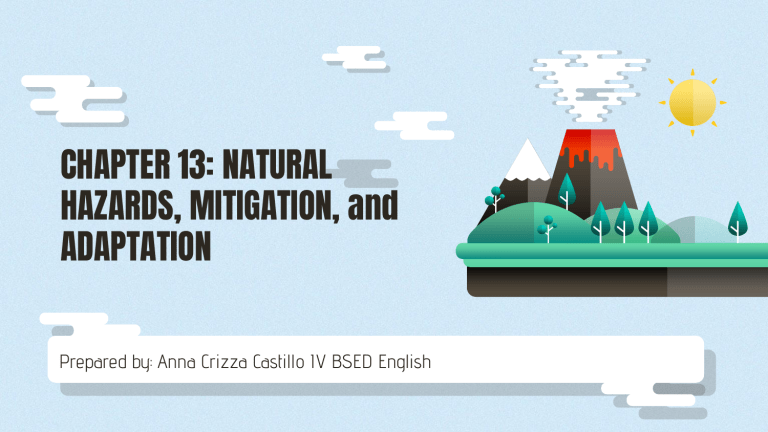
CHAPTER 13: NATURAL HAZARDS, MITIGATION, and ADAPTATION Prepared by: Anna Crizza Castillo IV BSED English Objectives: • describe the various hazards that may happen in the event of earthquakes, volcanic eruptions, and landslides (S11/I2ES -If-30) • using hazard maps, identify areas prone to hazards brought about by earthquakes, volcanic eruptions, and landslides(Sl1/12ES-If-31) • give practical ways of coping with geological hazards caused by earthquakes, volcanic eruptions, and landslides (S11/12ES-If-32) LESSON: HAZARD FROM GEOLOGIC PROCESSES • Refer 379-388. Read and analyze the geological processes and hazards. • Please watch the provided video about "hazard caused by geological processes” • Source: https://www.youtube.eom/watch?v=cqCHtePMC8E Geologic Processes and Hazards Hazards, Risk, Vulnerability, and Disasters Hazards are phenomena that have the potential to bring damage to humans and properties. Exposure is the potential of humans and properties to become exposed to hazards. Vulnerability encompasses the mitigation efforts to reduce the effects of hazards which is dictated by a number of factors such as poverty indices, etc. Hazards, Risk, Vulnerability, and Disasters Risk is simply the collective effects of hazards, exposure, and associated vulnerabilities. Exposure is the potential of humans and properties to become exposed to hazards. Earthquake Earthquake is the intense ground shaking or movement caused by a sudden release of energy. Earthquakes can be generated by a bomb blasts, volcanic eruptions, and most commonly, slippage along faults and subduction zones. Generating Earthquakes Elastic Rebound Theory The theory simply states that the generation of earthquakes goes into four stages: (1) Original Position (2) Build-up of strain (3) Rupture or slippage (4) The release of energy Seismology: The study of seismic waves Earthquakes release tremendous amount of energy in the form of seismic waves. .These seismic waves travel through the medium (rocks) and are recorded by an instrument called the seismometer. Two Types of Seismic Waves Body waves come from the focus and emanate in all directions through the interior of the Earth. Surface waves travel only on the surface similar to water waves. Two Subtypes of Body waves P-waves are capable through solid and liquid medium S-waves can only travel through solids. of travelling Describing an Earthquake Magnitude estimation of the amount of energy released at the source of the earthquake. Intensity refers to the degree of ground shaking at a given locality. Describing an Earthquake I Not felt. II Felt indoors by persons. III Vibration at rest, on like upper passing floors of ,light or favorable trucks. placed. IV Vibration like passing of heavy trucks. V Felt outdoors. Small unstable objects displaced or upset. VI Felt by a II, Furniture moved. Weak plaster/masonry cracks. VII Difficult to stand. Damage to masonry and chimneys. VIII Partial collapse of masonry. Frame houses moved. IX Masonry seriously damaged or destroyed. X Many buildings and bridges destroyed XI Rails bent greatly. Pipelines severely damaged. XII Damage nearly total. Epicenter Epicenter is defined as the geographic (inapt-locatable) location where the source of the earthquake or energy release is. Earthquake Effects 1. Wave amplitude. It refers to the highest point of shaking recorded on seismographs. 2. Duration of vibration. Earthquakes usually last for a few seconds to minutes. With an increase in earthquake duration, the ground shaking intensifies and will have detrimental effects to structures. 3. Nature of bedrock. Bedrock refers to the nature of the material where structures are built. Material could range from solid rocks to unconsolidated sediments and soil. Earthquake Effects 4. Design of Structure. Design of structure refers to the integrity of buildings to resist ground motion during an earthquake. The Future of Earthquake Studies The occurrence of earthquakes throughout human history has brought immeasurable damages to lives and property. At the same time, their occurrence has provided us with a picture of what goes underneath the planet. Earthquakes are reflections that geologic processes are at work and will continue to affect us in the future. Volcanic Eruptions Volcanoes have been one of the most visible evidences that there is so much heat at the Earth's interior. It compose of glowing lava, ash, and rock debris that are ejected by volcanoes during their eruption. Volcano Hazards Communities living near an active volcano should be aware of the different hazards accompanied with living close to such geologic feature. This does not necessarily mean that anyone living far from a volcano should feel safer than those who are close. VOLCANO HAZARDS 1. Lava is a mixture of dominantly molten rock that is several hundreds of degrees in temperature. 2. Pyroclastic flows have high temperatures and are generally gas-rich making their transport down the slopes of a volcano very fast compared to lava flows. 3. Lahar is a special term for a volcanic mudflow. It is similar to a mudflow but only involving volcanic materials (pyroclastic). VOLCANO HAZARDS 4. Gas contributes to the overall greenhouse gases aside from oxygen and water vapor, volcanoes which is present in the atmosphere during its activity (carbon dioxide, sulphur dioxide, hydrogen sulphide, etc.). 5. Ash is the smallest the pyroclastic unit (<2mm) produced from the fragmentation during a volcanic activity. Being small and produced at large volumes, ash is considered one of the most widespread hazard from volcanic eruptions. Volcano monitoring Volcano monitoring involves the assessment of different volcanic phenomena that may point out to a coming eruption. It is a very important tool that can lead to the safety of lives around an active volcano. Signs that a volcano will erupt: 1. Ground movement 2. Gas release Magma that is moving underground will show Being the lightest component of subtle to obvious changes on the surface prior magma, gas can easily exsolve or to an eruption. This sign can be monitored through GPS (global positioning systems) and remote sensing of areas around the volcano. separate from the magma and travel through fissures and cracks in the rocks and soil. Signs that a volcano will erupt: 3. Anomalous thermal signatures Magma slowly reaching the surface will 4. Chemical changes in nearby bodies of water Bodies of water near an active volcano heat up rocks and warm the surface. (including lakes formed at the vent or crater) Sometimes, if a body of water is present, will absorb the gases exsolved from the the increased temperature can dry up the magma. This "taking in" of gases will surface water in a matter of days. change the chemistry of the water that can be attributed to a coming eruption. Volcanic Hazards and the Survival of Man Monitoring the activity of volcanoes has prevented the loss of lives and properties. With the fast development of technology that allows us to have a greater understanding of magmatic processes, reduction of risks from volcanic hazards is inevitable but we are still far from this bright future. CREDITS: This presentation template was created by Slidesgo, including icons by Flaticon, infographics & images by Freepik
